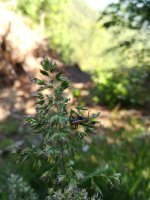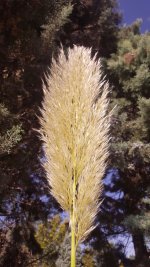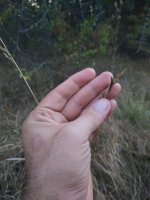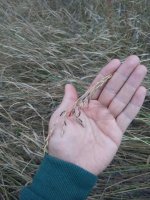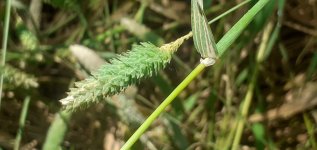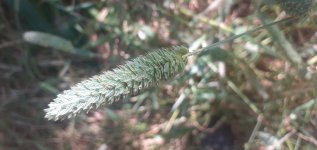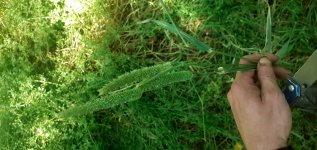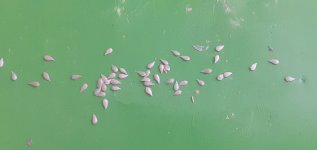-
Members of the previous forum can retrieve their temporary password here, (login and check your PM).
You are using an out of date browser. It may not display this or other websites correctly.
You should upgrade or use an alternative browser.
You should upgrade or use an alternative browser.
Phalaris/other grass types ID thread
- Thread starter zombicyckel
- Start date
Migrated topic.
Arundinacea is one species which I am not confident in identifying yet. I would vote no but Chimp z would know better.
I am now confident that the grass on the photos from post #302 are NOT Phalaris arundinacea.
dimitrious
Rising Star
Anything recognizable here?










None are Phalaris.
The above photo is most likely Cortaderia selloana. I could not find any information on possible alkaloid content.
Blazon
Rising Star
I have Phalaris aquatica growing in my back garden,next doors had a pond some time ago and it's growing inbetween concreat slabs in my garden.
just noticed pictures and pretty much in every picture I can see full hand etc ....
it isn't that hard if you wanted to to take FINGER PRINTS ....
when I was renewing my passport my finger prints got taken so I am in a database now myself
Harm reduction/security dear Nexus members
just noticed pictures and pretty much in every picture I can see full hand etc ....
it isn't that hard if you wanted to to take FINGER PRINTS ....
when I was renewing my passport my finger prints got taken so I am in a database now myself
Harm reduction/security dear Nexus members
Blazon
Rising Star
I am native to central Europe and looking at these pictures,Phalaris is what I used to put in my mouth and chew on as a kid when collecting mushrooms or fishing....remember it had kind of sweet taste to it....
so today I realized I been munching on DMT since I was probably 5 years old :thumb_up:
I am talking about the stems not leafs
so today I realized I been munching on DMT since I was probably 5 years old :thumb_up:
I am talking about the stems not leafs
Nice Blazon, you're a natural born DMT eater 
Good point about the fingerprints, it would be smart to not show hands in photos uploaded here.
Good point about the fingerprints, it would be smart to not show hands in photos uploaded here.
Era/is
Rising Star
About grasses:
Indole alkaloids are responsible for toxicity of
Phalaris pastures to sheep and cattle [l-3]. Several of these alkaloids are present in various species of Gramineae, Leguminosae and other plant families [4]. Simple indole bases such as 3-N,Ndimethylaminomethylindole (gramine)
5-methoxy-N,N-dimethyltryptamine (MOM2T, 2), 5- methoxytryptamine (MOT, 3) and N,-methyltryptamine (MT, 4)
...total alkaloid content varies between 0.02-1.19 of dry wt in Phalaris arundinacea [7]
and gramine concentration may reach up to 7 mmol/kg fr. wt in barley,
..Several plant secondary metabolites are thought to protect plants against insects and patho- gens. For example, hydroxamic acids from Gramineae have been suggested to protect wheat and maize against the European corn borer.
Always known for the property of selectively chelating metals, forming stable products especially with Cu2 +, Fe3 +, V5 +, UO22 +. They have also been studied for the realization of polymer chains with chelating properties to be used in the selective removal of heavy metals [2] [3] Some hydroxamic acids such as SAHA, Vorinostat, PXD101 and Belinostatin, LAQ824 / LBH589 and Trichostatin A, are HDAC inhibitors with anticancer properties.
Indole alkaloids are responsible for toxicity of
Phalaris pastures to sheep and cattle [l-3]. Several of these alkaloids are present in various species of Gramineae, Leguminosae and other plant families [4]. Simple indole bases such as 3-N,Ndimethylaminomethylindole (gramine)
5-methoxy-N,N-dimethyltryptamine (MOM2T, 2), 5- methoxytryptamine (MOT, 3) and N,-methyltryptamine (MT, 4)
...total alkaloid content varies between 0.02-1.19 of dry wt in Phalaris arundinacea [7]
and gramine concentration may reach up to 7 mmol/kg fr. wt in barley
..Several plant secondary metabolites are thought to protect plants against insects and patho- gens. For example, hydroxamic acids from Gramineae have been suggested to protect wheat and maize against the European corn borer.
Always known for the property of selectively chelating metals, forming stable products especially with Cu2 +, Fe3 +, V5 +, UO22 +. They have also been studied for the realization of polymer chains with chelating properties to be used in the selective removal of heavy metals [2] [3] Some hydroxamic acids such as SAHA, Vorinostat, PXD101 and Belinostatin, LAQ824 / LBH589 and Trichostatin A, are HDAC inhibitors with anticancer properties.
ppancho.villa
Rising Star
Hi to all
someone from help will help me.
is Aquatica phalaris?
Thanks
Screenshot
Screenshot
Screenshot
someone from help will help me.
is Aquatica phalaris?
Thanks
Screenshot
Screenshot
Screenshot
Attachments
That looks like aquatica.
neurobloom
Established member
It might as well be minor we cant tell until we inspect the seeds. One way to rule out phalaris minor os to uproot the plant and takea a close up pic of the root tips of the new root growth. If its pink it's fair to say with a reasonable accuracy that it's minor. This is the method that is suggested by crop scientists to farmers to identify phalaris minor infestation within a feild of phalaris aquatica. Root tips plus seeds should give us a very accurate taxonomy.
ppancho.villa
Rising Star
neurobloom
Established member
Those seeds are minor.
ppancho.villa
Rising Star
Thank you

